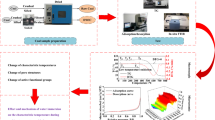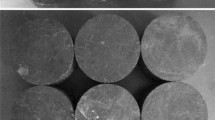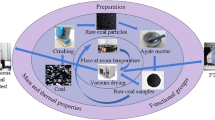Abstract
Liquid nitrogen freeze–thaw has been used in oil, shale gas and coalbed methane exploitation as an efficient fracturing technology. This paper aimed to study the effect of different coal ranks and liquid nitrogen soaking times on the temperature distribution of coal samples, and to explore the temperature evolution mechanism of different coal ranks during liquid nitrogen soaking. For these objectives, the temperature change process, thermophysical parameters and infrared spectrum of different coal ranks under liquid nitrogen soaking were tested using, respectively, (a) liquid nitrogen soaking temperature measurement, (b) laser thermal instrument and (c) Fourier transform infrared spectrometer. The results showed that the temperature curves of coal samples under liquid nitrogen soaking were divided into an accelerated cooling stage I, a decelerated cooling stage II, and a maintained low-temperature stage III. As the number of liquid nitrogen soaking increased, the time required to reach low-temperature Stage III gradually shortened. During the rise in coal sample temperature, it increased with time in accordance with a logarithmic function. The order of absolute values of maximum heating/cooling speed was lignite > bituminite > anthracite. The higher coal rank is, more oxygen-containing functional groups were removed by coalification. The less content of oxygen-containing functional groups led to closer molecular structure, which resulted in smaller thermal conductivity and ultimately caused slower temperature transfer. The study results are of important guides to understand further the action process and mechanism of liquid nitrogen soaking on coal.














Similar content being viewed by others
References
Al-Abri, A., Sidiq, H., & Amin, R. (2012). Mobility ratio, relative permeability and sweep efficiency of supercritical CO2 and methane injection to enhance natural gas and condensate recovery: Core flooding experimentation. Journal of Natural Gas Science and Engineering, 9, 166–171.
Boudent, H., Clarke, C., Bugden, D., Maibach, E., Roser-Renouf, C., & Leiserowitz, A. (2014). “Fracking” controversy and communication: using national survey data to understand public perceptions of hydraulic fracturing. Energy Policy, 65, 57–67.
Cai, C. Z., Li, G. S., Huang, Z. W., Shen, Z. H., Tian, S. C., & Wei, J. W. (2014). Experimental study of the effect of liquid nitrogen cooling on rock pore structure. Journal of Natural Gas Science and Engineering, 21, 507–517.
Cha, M. S., Yin, X. L., Kneafsey, T., Johanson, B., Alqahtani, N., Miskimins, J., et al. (2014). Cryogenic fracturing for reservoir stimulation—Laboratory studies. Journal of Petroleum Science and Engineering, 124, 436–450.
Chaudhary, G., & Li, R. (2014). Freezing of water droplets on solid surfaces: An experimental and numerical study. Experimental Thermal and Fluid Science, 57(3), 86–93.
Coetzee, S., Neomagus, H. W. J. P., Bunt, J. R., Strydom, C. A., & Schobert, H. H. (2014). The transient swelling behaviour of large (−20 + 16 mm) South African coal particles during low-temperature devolatilisation. Fuel, 136, 79–88.
Feng, Z., Zhou, D., Zhao, Y., & Cai, T. T. (2016). Study on microstructural changes of coal after methane adsorption. Journal of Natural Gas Science and Engineering, 30(5), 28–37.
Fu, X. H., Qin, Y., Wang, G. X., & Rudolph, V. (2009). Evaluation of coal structure and permeability with the aid of geophysical logging technology. Fuel, 88(11), 2278–2285.
Gangopadhyay, P. K., Maathuis, B., & Van Dijk, P. (2005). ASTER-derived emissivity and coal-fire related surface temperature anomaly: A case study in Wuda, North China. International Journal of Remote Sensing, 26(24), 5555–5571.
Guo, Y. T., & Bustin, R. M. (1998). Micro-FTIR spectroscopy of liptinite macerals in coal. International Journal of Coal Geology, 36(3), 259–275.
He, X. Q., Liu, X. F., Nie, B. S., & Song, D. Z. (2017). FTIR and Raman spectroscopy characterization of functional groups in various rank coals. Fuel, 206, 555–563.
Hebblewhite, B., & Galvin, J. (2017). A review of the geomechanics aspects of a double fatality coal burst at Austar Colliery in NSW, Australia in April 2014. International Journal of Mining Science and Technology, 27(1), 3–7.
Ibarra, J. V., Munoz, E., & Moliner, R. (1996). FTIR study of the evolution of coal structure during the coalification process. Organic Geochemistry, 24(6), 725–735.
Javadpour, F., McClure, M., & Naraghi, M. E. (2015). Slip-corrected liquid permeability and its effect on hydraulic fracturing and fluid loss in shale. Fuel, 160, 549–559.
Keith, F. E., Alba, Z., Toni, K., Nicolas, D., & Fabio, M. (2012). A survey of the induced seismic responses to fluid injection in geothermal and CO2 reservoirs in Europe. Geothermics, 41(1), 30–54.
Kim, K., Kemeny, J., & Nickerson, M. (2014). Effect of rapid thermal cooling on mechanical rock properties. Rock Mechanics and Rock Engineering, 47(6), 2005–2019.
Li, H., Lin, B., Yang, W., Zheng, C. S., Hong, Y. D., Gao, Y. B., et al. (2016a). Experimental study on the petrophysical variation of different rank coals with microwave treatment. International Journal of Coal Geology, 154–155, 82–91.
Li, H. Y., Ogawa, Y., & Shimada, S. (2003). Mechanism of methane flow through sheared coals and its role on methane recovery. Fuel, 82(10), 1271–1279.
Li, W., Zhu, Y., Chen, S., & Zhou, L. (2013). Research on the structural characteristics of vitrinite in different coal ranks. Fuel, 107(3), 647–652.
Li, X. L., Li, Z. H., & Wang, E. Y. (2018). Pattern recognition of mine microseismic (MS) and blasting events based on wave fractal features. Fractals, 26(3), 1850029.
Li, X. S., Ju, Y. W., Hou, Q. L. H., & Lin, H. (2012). Spectra response from macromolecular structure evolution of tectonically deformed coal of different deformation mechanisms. Science China Earth Sciences, 55(8), 1269–1279.
Li, Z. F., Xu, H. F., & Zhang, C. Y. (2016b). Liquid nitrogen gasification fracturing technology for shale gas development. Journal of Petroleum Science and Engineering, 138, 253–256.
Li, Z. K., Wei, X. Y., Yan, H. L., & Zong, Z. M. (2015). Insight into the structural features of zhaotong lignite using multiple techniques. Fuel, 153(1), 176–182.
Liu, S. M., Li, X. L., Wang, D. K., Wu, M. Y., & Yin, G. Z. (2020a). Mechanical and acoustic emission characteristics of coal at temperature impact. Natural Resources Research, 29(6), 1755–1772.
Liu, S. M., Wang, D. K., Yin, G. Z., Li, M. H., & Li, X. L. (2020b). Experimental study on the microstructure evolution laws in coal seam affected by temperature impact. Rock Mechanics and Rock Engineering, 53(3), 1359–1374.
Majumder, A. K., Jain, R., Banerjee, P., & Barnwal, J. P. (2008). Development of a new promimate analysis based correlation to predict calorific value of coal. Fuel, 13(14), 3077–3081.
Mcdaniel, B. W., Grundmann, S. R., Kendrick, W. D., Wilson, D. R., & Jordan, S. W. (1997). Field applications of cryogenic nitrogen as a hydraulic fracturing fluid. In Proceedings-SPE annual technical conference and exhibition, Delta, pp. 561–572.
Mcdermott, C. I., Randriamanjatosoa, A. R. L., Tenzer, H., & Kolditz, O. (2006). Simulation of heat extraction from crystalline rocks: the influence of coupled processes on differential reservoir cooling. Geothermics, 35(3), 321–344.
Mitra, A., Harpalani, S., & Liu, S. M. (2012). Laboratory measurement and modeling of coal permeability with continued methane production: Part 1—Laboratory results. Fuel, 94(8), 110–116.
Mottaghy, D., & Rath, V. (2006). Latent heat effects in subsurface heat transport modelling and their impact on palaeotemperature reconstructions. Geophysical Journal of the Royal Astronomical Society, 164(1), 236–245.
Moukhtari, F. E., & Lecampion, B. (2018). A semi-infinite hydraulic fracture driven by a shear-thinning fluid. Journal of Fluid Mechanics, 838, 573–605.
Muchnik, S. V. (2010). Pre-stressing of an open pit bench during large-scale blasting. Journal of Mining Science, 46(6), 650–655.
Nie, B. S., Liu, X. F., & Liu, S. F. (2016). Sorption characteristics of methane among various rank coals: Impact of moisture. Adsorption, 22(3), 315–325.
Park, C., Synn, J., Shin, H., Shin, H. S., Cheon, D. S., Lim, H. D., et al. (2004). Experimental study on the thermal characteristics of rock at low temperatures. International Journal of Rock Mechanics and Mining Sciences, 41(3), 367–368.
Peng, H., Feng, G., Yang, J., & Gao, Y. N. (2016). Changes in pore structure and permeability of low permeability coal under pulse gas fracturing. Journal of Natural Gas Science and Engineering, 34, 1017–1026.
Puller, J. W., Mills, K. W., Jeffrey, R. G., & Walker, R. J. (2016). In-situ stress measurements and stress change monitoring to monitor overburden caving behaviour and hydraulic fracture pre-conditioning. International Journal of Mining and Science and Technology, 26, 103–110.
Qin, L., Zhai, C., Liu, S., Xu, J. Z., Yu, G. Q., & Sun, Y. (2017). Changes in the petrophysical properties of coal subjected to liquid nitrogen freeze-thaw—A nuclear magnetic resonance investigation. Fuel, 194, 102–114.
Shaheed, R., Kevin, C., & Hye, Y. (2016). Review on a traditional herbal medicine, eurycoma longifolia jack (tongkat ali): Its traditional uses, chemistry, evidence-based pharmacology and toxicology. Molecules, 21(3), 331–345.
Shen, Y., Yang, Y., Yang, G., Hou, X., Ye, W. J., You, Z. M., et al. (2018). Damage characteristics and thermo-physical properties changes of limestone and sandstone during thermal treatment from −30°C to 1000°C. Heat Mass Transfer, 54(5), 3389–3407.
Sun, W. J., Feng, Y. Y., Jiang, C. F., & Chu, W. (2015). Fractal characterization and methane adsorption features of coal particles taken from shallow and deep coalmine layers. Fuel, 155(9), 7–13.
Vishal, V., Singh, T. N., & Ranjith, P. G. (2015). Influence of sorption time in CO2-ECBM process in Indian coals using coupled numerical simulation. Fuel, 139, 51–58.
Wadhwa, P., Aron, M., Bal, C. S., Dhanpatty, B., & Gupta, N. P. (2007). Critical prospective appraisal of renal morphology and function in children undergoing shockwave lithotripsy and percutaneous nephrolithotomy. Journal of Endourology, 21(9), 961–966.
Wang, D. K., Liu, S. M., Wei, J. P., Wang, H. L., & Yao, B. H. (2017a). A research study of the intra-nanopore methane flow law. International Journal of Hydrogen Energy, 42(29), 18607–18613.
Wang, D. K., Wei, J. P., Fu, Q. C., Liu, Y., & Xia, Y. L. (2015a). Seepage law and permeability calculation of coal gas based on Klinkenberg effect. Journal of Central South University, 22(5), 1973–1978.
Wang, D. K., Yao, B. H., Gao, Y. N., Li, W., & Lv, R. (2017b). Effect of cyclic temperature impact coal seam permeability. Thermal Science, 21(s1), 351–357.
Wang, H. C., Fu, X. H., Jian, K., Li, T., & Luo, P. P. (2015b). Changes in coal pore structure and permeability during N2 injection. Journal of Natural Gas Science and Engineering, 27, 1234–1241.
Watanabe, K., & Mizoguchi, M. (2002). Amount of unfrozen water in frozen porous media saturated with solution. Cold Regions Science and Technology, 34(2), 103–110.
Xu, J., Cheng, Z., & Lei, Q. (2017). Mechanism and application of pulse hydraulic fracturing in improving drainage of coalbed methane. Journal of Natural Gas Science and Engineering, 40, 79–90.
Yan, F. Z., Lin, B. Q., Zhu, C. J., Guo, C., Zhou, Y., Zou, Q. L., et al. (2016). Using high-voltage electrical pulses to crush coal in an air environment: An experimental study. Powder Technology, 298, 50–56.
Yin, G. Z., Li, M. H., Wang, J. G., Xu, J., & Li, W. (2015). Mechanical behavior and permeability evolution of gas infiltrated coals during protective layer mining. International Journal of Rock Mechanics and Mining Science, 80, 292–301.
Zhang, D., Gu, L., Li, S., Lian, P., & Tao, J. (2013). Interactions of supercritical CO2 with coal. Energy & Fuels, 27(1), 387–393.
Zhang, R., Liu, J., & Sa, Z. Y. (2020). Fractal characteristics of acoustic emission of gas-bearing coal subjected to true triaxial loading. Measurement. https://doi.org/10.1016/j.measurement.2020.108349.
Zhou, F., Sun, W. B., Shao, J. L., Kong, L. J., & Geng, X. Y. (2020). Experimental study on nano silica modified cement base grouting reinforcement materials. Geomechanics and Engineering, 20(1), 67–73.
Acknowledgments
The authors would like to acknowledge the financial support from National Natural Science Foundation of China (Grant Number: 51774118), the State Key Laboratory Cultivation Base for Gas Geology and Gas Control (Henan Polytechnic University) (Grant Number: WS2019B02), Natural Science Foundation of Chongqing, China (Grant Number: cstc2019jcyj-bsh0041), the Postdoctoral Science Foundation Project Funded by State Key Laboratory of Coal Mine Disaster Dynamics and Control (Grant Number: 2011DA105287-BH201903) and the Chinese Ministry of Education Innovation Team Development Plan (Grant Number: IRT_16R22).
Author information
Authors and Affiliations
Corresponding authors
Rights and permissions
About this article
Cite this article
Liu, S., Li, X., Wang, D. et al. Experimental Study on Temperature Response of Different Ranks of Coal to Liquid Nitrogen Soaking. Nat Resour Res 30, 1467–1480 (2021). https://doi.org/10.1007/s11053-020-09768-3
Received:
Accepted:
Published:
Issue Date:
DOI: https://doi.org/10.1007/s11053-020-09768-3




